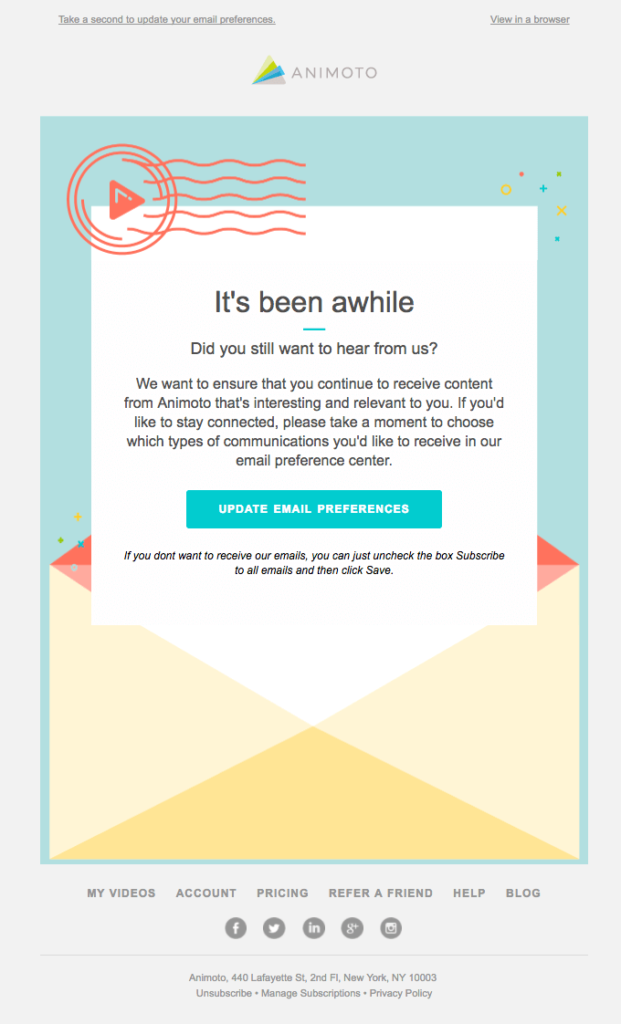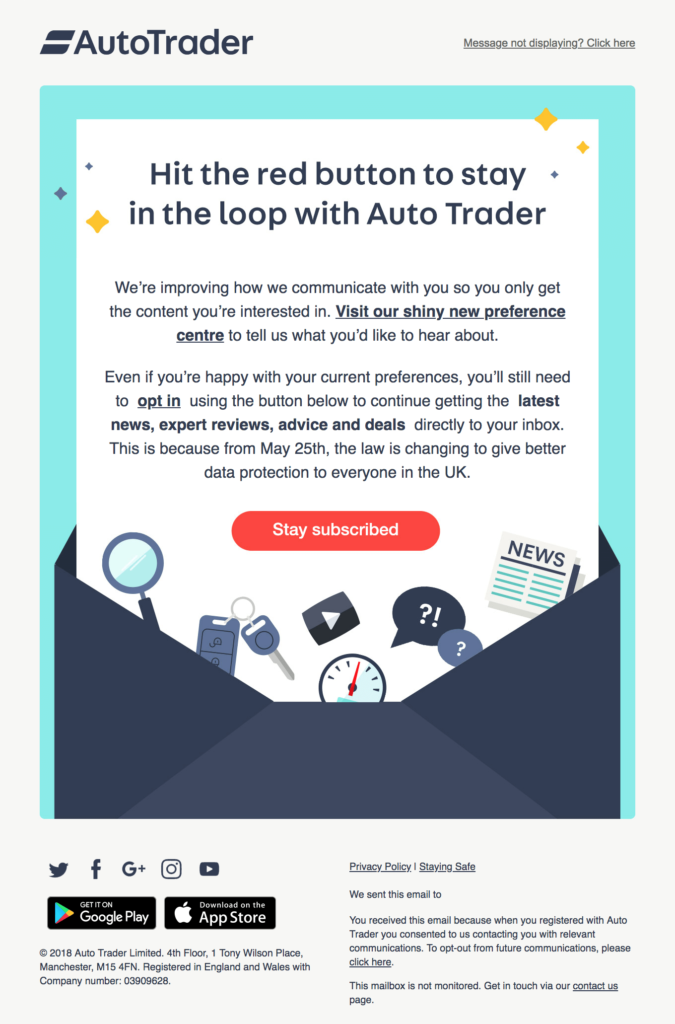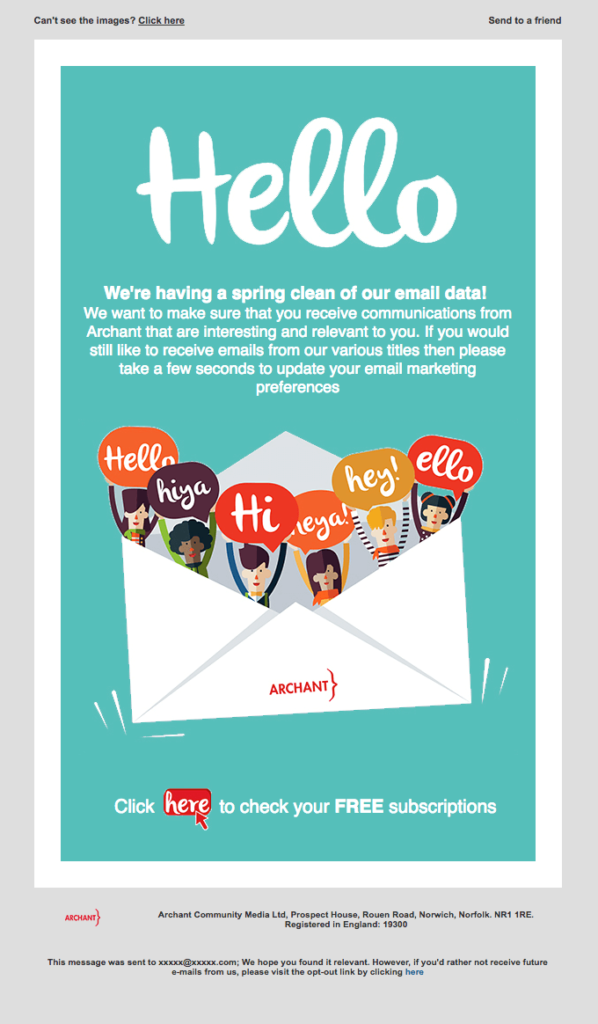The main focus of many companies is growing their email list. While it is important to consistently add new subscribers to your list, it’s only half of the equation. The other half consists of maintaining and cleaning your email list.
Having a huge list full of uninterested, disengaged or irrelevant contacts means that you are wasting money, time and possibly hurting your email deliverability.
In this article we share our best tips and advice to maintain a healthy and clean email list.
Why a healthy and clean email list matters
There are many advantages of sending emails to a smaller, cleaner and healthier list that will impact your email marketing results directly. Let’s have a closer look.
Lower costs
It doesn’t make sense to spend time and money on people that aren’t interested in your company. Many email service providers charge by the size of your list so spending time pruning and removing outdated and irrelevant contacts can decrease the cost of your email marketing.
Less spam complaints
When you have many subscribers on your email list who don’t want to hear from you, there is a bigger chance your emails will be reported as spam. Do yourself (and them) a favor, and remove anyone from your list that doesn’t show interest or hasn’t been engaging with you. Having less spam complaints will positively impact your email deliverability.
More accurate reporting
Instead of dealing with uninterested and non-active subscribers who drag down your email marketing performance, you’ll have the opportunity to see the actual results of your efforts. This means that your reports will look more optimistic and you’ll be able to see and prove the true value of email marketing.
Better results
With more engaged and interested people on your email list, your email campaigns will perform better and your results will improve. You’ll see more opens and more clicks and eventually, a better ROI. And that’s what we’re all striving for, right?
How to know when you need to clean your email list
You have low open rates and low click rates
When these numbers are way too low, you might have some bad contacts hidden in your email list. Time to get them out!
You have high bounce rates
This could indicate that you have a lot of outdated email addresses that are not active anymore. Better track down the ones that bounce and remove them from your list. Your email deliverability will thank you.
You get a lot of spam complaints
We’ve said it before, but we’ll say it again. When you’re sending emails to people who don’t want to hear from you, you’ll probably get spam complaints. This can happen when subscribers have no clue how they ended up on the list (because they subscribed a long time ago or because they haven’t heard from you in a long time). Another reason for getting spam complaints, and this one is even worse, is because you have bought or rented an email list. In that case, people on the list haven’t given consent to receive emails from you. The ultimate recipe for a click on the unsubscribe or spam button.
You have a low deliverability rate
Nothing is more harmful to your email deliverability than ignoring high bounce rates and/or spam complaints, and especially not cleaning your email list. Luckily, it’s never too late to recover from a low deliverability rate but you’ll definitely need to make a priority of cleaning your email list. We’ll explain how to do this.
Our best tips for maintaining a healthy and clean email list
Never buy email lists
Really, don’t. There are just way too many reasons why buying email lists will backfire on your business reputation.
Quality in = quality out
Just like keeping your house clean, it’s always easier for everyone if you know where to find and put stuff: shoes, charging cables, kitchen utensils,…
A great starting point to keep your email list clean is to set up some ground rules about organizing your data and making sure that everyone follows those rules.
Think about how messy your customer data can be when you have multiple signup forms on your website, a couple of separate landing pages, and an offline signup form for events. Especially when your entry fields aren’t consistent either. For example, gender could be inserted as M, Man or Male. Or when you have two different fields for a first and last name, but another form has one field for the full name.
See where we’re going with this?
That’s why it’s important to have a uniform way of putting customer data in your email list. And all your co-workers from development, marketing and sales should be up-to-date about these rules.
Another great tip is to include real-time validation in your signup forms. Has the email address been written correctly? Is the ZIP code really a number? Have all fields been filled out correctly? You get the point.
Clean duplicate email addresses
In general, an email address is the digital ID of a person. You should always avoid having duplicate email addresses in your email list because this means that you are gathering information about the same person in two different locations.
Instead, you should always strive to have one single customer view. All information about one person should be linked to the same email address.
The first step to achieve this is to combine or remove duplicate email addresses.
In addition, you’re doing your customer a favor because (s)he won’t receive your emails twice anymore.
Use a double opt-in
By using a double opt-in, you make sure that someone who signs up REALLY wants to receive your emails.
You basically send an email to them asking to confirm their email address before you put them on your email list.
It’s a bulletproof way to avoid gathering fake or mistyped email addresses in your email list. It helps you reduce hard bounces and improves your overall engagement and deliverability.
Remove your bounces and unsubscribes
When an email bounces, it means that it can’t be received by the person you’re sending to. There are 2 kinds of bounces: hard bounces and soft bounces.
Hard bounces happen because the email address is not valid. This could mean that there is a typo or that the email address doesn’t exist anymore. Because there is no use in sending emails to these kind of email addresses, your email service provider will remove hard bounces automatically.
Soft bounces are caused by a temporary problem with the email address or inbox of the receiver. For example, a full inbox or a technical issue. Your email service provider won’t remove these email addresses immediately. They will try again to deliver the email. But if the email keeps on bouncing, they will automatically remove the address from your list.
It’s worth diving in the details of why an email has bounced. Check for obvious typos (like @gmial.com, or hotmai.com) and adjust them manually. The next time you send an email to that email address, it should come through.
Besides bounces, there’s also the people who unsubscribe from your email messages. If this happens, they should be removed immediately from your list. Not only is it against the law to keep sending them messages, but you can also drastically hurt your future email deliverability if they start indicating your emails as spam.
Luckily, most email service providers have a great unsubscribe system in place.
Remove generic and spammy email addresses
If you haven’t been using a double opt-in to validate email addresses, chances are that you have some weird looking email addresses on your email list.
Spam email addresses like r7548DS68@weirddomainname.ru add no value at all and should be removed.
Same goes for generic email addresses like webmaster@domainxyz.com or info@domainxyz.com. Remember that the best email addresses are personal email addresses. If you can’t reach a person directly, it’s better to avoid sending emails to the address altogether.
Segment your audience based on past engagement
Not every subscriber on your list reacts the same way to your email campaigns. Some people open and click all your campaigns, while others barely open or click any message at all.
A great starting point is to spend some time segmenting your audience into two different groups: active subscribers vs non-active subscribers. And then adjust your messages to them.
Active subscribers
- Reward them with exclusive deals, special promotions or giveaways.
- Ask them their opinion about your content and use their suggestions to improve your messages.
- Leverage their influence in referral campaigns to bring in new subscribers.
Non-active subscribers
- Use new email strategies and try to win back their interest. You can send other content, better promotions or send them fewer emails overall.
- Try to understand why they aren’t interacting with your content. By gathering feedback from them you can gain valuable insight which you can use to adjust sails.
Set up a re-engagement campaign
If your non-active subscribers keep ignoring your emails, maybe it’s time to give them an ultimatum. There’s no use in sending emails to people who don’t want to hear from you. In that case, it’s better to ask them if they still want to receive your emails or not. If they don’t reply, you can remove them from your email list.
Here are some examples of great and fun re-engagement email campaigns.

Source: reallygoodemails.com

Source: reallygoodemails.com

Source: reallygoodemails.com
Keep regular contact with your subscribers
Use software to clean your email list for you
Fortunately, a lot of email service providers already have systems in place that help you with cleaning your email list. Additionally, there is some great software available where you can upload your list and they will make a report for you with a cleaned version of your email list.
Some of our favorite tools are Datavalidation and Neverbounce.
When you’re managing an email list, you should always go for quality over quantity. Email list cleaning makes sure that you’re only sending messages to interested, engaged, relevant and up-to-date contacts. This will save you time, money and it will make your email marketing results better.
Are you having troubles dealing with a messy, unorganized or dirty email list? We can help you out with structuring, segmenting and cleaning your email list. Let’s talk!

Learn how to set up your perfect welcome email series
Sign up, get monthly email marketing awesomeness and our FREE GUIDE 'Turning subscribers into customers. Secrets of the perfect welcome email series' delivered to your inbox.


